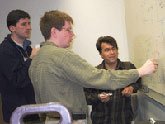A gathering place for great minds

By Silva Young
From eNews, July 24, 2008
The next time you're browsing the Web or having your groceries scanned at the supermarket, it's likely that theoretical physics won't be the first thing on your mind, unless you're a researcher at the University of Minnesota's William I. Fine Theoretical Physics Institute (FTPI). Founded more than 20 years ago, FTPI was largely the work of physics professor emeritus Stephen Gasiorowicz and University alumnus and Twin Cities_real-estate developer William Fine, who had a lifelong interest in the physical sciences._Convinced that the study of physics was vital to the advancement of civilization, Fine was interested in supporting the science. Together, Gasiorowicz and Fine came up with the idea of starting a theoretical physics institute, where researchers would perceive the universe in terms of waves and particles.
At the time, the University's administration was reluctant to approve a large initiative in the pure sciences. Encouraged by outgoing head of the University's School of Physics and Astronomy Charles Campbell, and his successor, Marvin Marshak, the University agreed to match Fine's gift and provide ongoing funds in 1986. The institute officially opened in January 1987, just before the dissolution of the Soviet Union, a period when scientists were suddenly able to travel more freely. The development would prove fortuitous for the institute. Several of FTPI's current faculty first came to the University as participants in the long-term visitor program. "Within a very short time, we had recruited five top-notch Russian physicists for permanent faculty positions," says Gasiorowicz, FTPI's first acting director.
They included Leonid Glazman, Mikhail Shifman, Boris Shklovskii, Arkady Vainshtein, and Mikhail Voloshin. These five, together with the later addition of Keith Olive, still make up the faculty today, with Voloshin serving as director. The late Anatoly Larkin was also a key member until his death in 2005. The institute's current list of theorists reads like a Who's Who among physicists. Glazman, Olive, Shklovskii, Shifman, Vainshtein, and Voloshin were elected fellows of the American Physical Society. Shklovskii received the prestigious Landau Prize, named after one of the century's most esteemed theoretical physicists. The American Physical Society awarded the J. J. Sakurai Prize to Vainshtein, Voloshin, and Shifman. Vainshtein also received the Pomeranchuk Prize, and Shifman was recently honored with the Lilienfeld Prize. "These people are truly leaders in their fields," says Allen Goldman, physics professor and head of the School of Physics and Astronomy. "In many cases, they define their fields." Today, FTPI occupies offices on the top floor of the University's physics building on the Twin Cities campus in Minneapolis, where the atmosphere continues to be decidedly international. Theorists often confer with one another in Russian, among other languages, and the manner in which they study physics and interact with their colleagues has a distinctly cosmopolitan flavor. Their research includes the major areas of theoretical physics: particle physics, astrophysics and cosmology, and condensed matter physics and biophysics. And their work is laying the groundwork for many new technologies such as medical imaging, computer-assisted surgery, emerging nanotechnology, computer miniaturization, more efficient power lines, and new cell phone technology. Their research is often the springboard for experiments conducted by other scientists. The institute has hosted more than 800 researchers from institutions in more than 18 countries for working visits of a day to six months. It also averages nearly 50 speakers a year. In addition to being passionate researchers, the scientists at FTPI are teachers and mentors. As University faculty, they teach courses, advise Ph.D. students, and mentor postdoctoral researchers. Many of their students have gone on to distinguished careers in university, industry, and laboratory settings such as the University of California, Berkeley; Lockheed Martin; and the European Organization for Nuclear Research. To learn more, visit the William I. Fine Theoretical Physics Institute.
